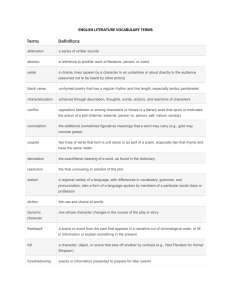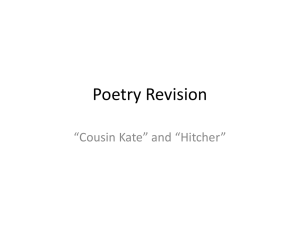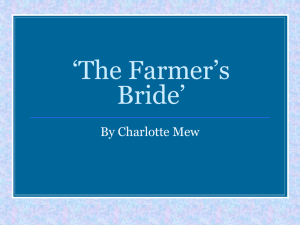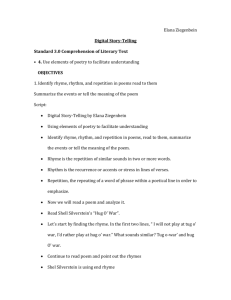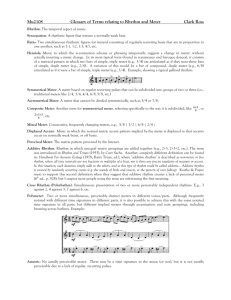Class Recorder Notes 9-19 Emma Sheldrick 2 new things on the lit
advertisement
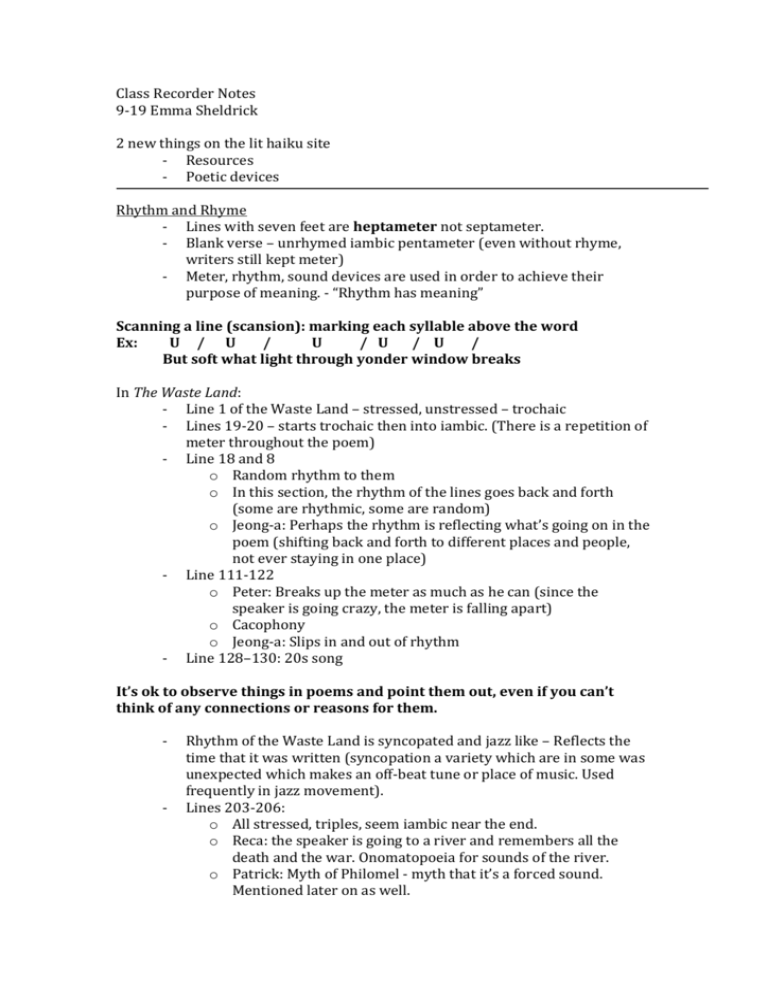
Class Recorder Notes 9-19 Emma Sheldrick 2 new things on the lit haiku site - Resources - Poetic devices Rhythm and Rhyme - Lines with seven feet are heptameter not septameter. - Blank verse – unrhymed iambic pentameter (even without rhyme, writers still kept meter) - Meter, rhythm, sound devices are used in order to achieve their purpose of meaning. - “Rhythm has meaning” Scanning a line (scansion): marking each syllable above the word Ex: U / U / U / U / U / But soft what light through yonder window breaks In The Waste Land: - Line 1 of the Waste Land – stressed, unstressed – trochaic - Lines 19-20 – starts trochaic then into iambic. (There is a repetition of meter throughout the poem) - Line 18 and 8 o Random rhythm to them o In this section, the rhythm of the lines goes back and forth (some are rhythmic, some are random) o Jeong-a: Perhaps the rhythm is reflecting what’s going on in the poem (shifting back and forth to different places and people, not ever staying in one place) - Line 111-122 o Peter: Breaks up the meter as much as he can (since the speaker is going crazy, the meter is falling apart) o Cacophony o Jeong-a: Slips in and out of rhythm - Line 128–130: 20s song It’s ok to observe things in poems and point them out, even if you can’t think of any connections or reasons for them. - - Rhythm of the Waste Land is syncopated and jazz like – Reflects the time that it was written (syncopation a variety which are in some was unexpected which makes an off-beat tune or place of music. Used frequently in jazz movement). Lines 203-206: o All stressed, triples, seem iambic near the end. o Reca: the speaker is going to a river and remembers all the death and the war. Onomatopoeia for sounds of the river. o Patrick: Myth of Philomel - myth that it’s a forced sound. Mentioned later on as well. - - Eliot mixes formal writing and rhyming techniques. Uses other sound techniques to create a unity in the poem (consonance, assonance, alliteration, etc.). Line 235 – 238: o Sonnet form o Even though he rejects all romantic forms, he puts a sonnet in there. o Jae Hyun- Disapproves of sonnets, so tries to put something that should’ve been love, but isn’t, into sonnet form. It creates irony. Eliot replaces rhyme with repetition in the beginning of the poem. (Repeats words like rock, shadow, only, and ing words). Lines 182 o Rhyme (song, long, hear, ear), stop rhyme throughout the stanza, then starts again near the end (year, hear, bring, spring…). o Kat: He could be jarring the writing to help focus the more jarring images o He also uses a repetition of syntax and phrases Ex: “hurry up please it’s time”, “there is not even” o Repetition of images Ex: “there is no water” o He uses “DA DA DA” which is then reflected again later on in the poem as “datta, dayadhvam, damyata”. End-stopped line – read at the end of the line (phrase) Enjambment – a line that’s meant to be read through to the next line without stopping Caesura – break in mid-line For next class: Pick out certain lines in your passages to use as examples to discuss with your essay. Reflection: This class was interesting for me because I’ve never really studied about rhythm and the different effects it has on a poem. It never really occurred to me that rhythm could have an impact on the text, so when we started discussing the ways it affects the meaning of the poem I was intrigued. The one example that really stood out to me was the idea that the rhythm in the Wasteland is always changing to possibly give the effect of the constant changing in speaker and scenery. Once that was mentioned in our class discussion, it didn’t really affect the way I understood the poem and how I looked at it, but it did make me truly appreciate the ingenuity of this poem and Eliot’s dedication to his work. Going over these different kinds of rhythm in detail did help me a lot since I’ve never really bean taught the different meters in class so that little bit of review helped clear up what the different meter mean and therefore will allow me to look at poetry in more detail.

